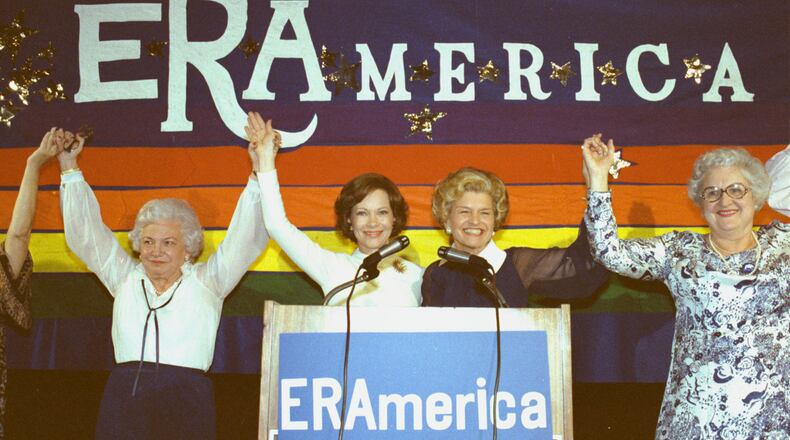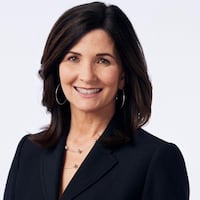The role of first lady may be the most difficult in politics, whether it’s at the state or national level. Alternately put on a pedestal and underestimated, the first lady’s job is all-consuming and unpaid, ill-defined, and highly scrutinized.
The first American first lady, Martha Washington, once wrote to her niece that she felt like a “Chief State Prisoner.” And former First Lady Michelle Obama agreed that life in the White House “is like a really nice prison.”
But former first lady Rosalynn Carter never seemed to chafe at the role after Jimmy Carter was elected in 1976. She relished it, telling interviewers in later years that she considered the White House a refuge for her family. And far from limiting, she felt the role gave her the biggest opportunity she’d ever had.
“When I came to Washington I knew what I wanted to do,” she said in a 1994 interview. She’d already worked on mental health issues as first lady of Georgia and saw a chance to do more. “I couldn’t wait to get to Washington to work on mental health because I had a chance to do it for the whole country.”
Along with knowing what she wanted to do, Rosalynn Carter had other advantages going into the White House that not all first ladies did. For one, she’d already been first lady of Georgia, where she adjusted to life in a public house and a public role. She had also been eager for her husband to win the White House.
“It’s tough to imagine, but if one person wants him to be president more than Jimmy, it’s Rosalynn,” Hamilton Jordan told the Washington Post in 1976.
The same article described Rosalynn as “nourished by campaigning” and, like her husband, “unquenchably self-confident and ambitious.” But she explained in the piece that she just believed her husband was the best person to lead the country.
Although Hillary Clinton was thought of as the first agenda-focused first lady in modern times, it was really Rosalynn Carter who changed the location and the function of the first lady’s office almost as soon as she got there.
Instead of working out of a room or desk in the family quarters, she moved her office to the East Wing where the first lady’s staff was already placed.
After a few days, she realized that the first lady had four secretaries for personal correspondence and social scheduling, but none to help her execute a policy agenda on mental health or her other priorities, like getting the Equal Rights Amendment ratified across the country.
“I had all kinds of plans,” she said in 2007. “After several weeks, we created a brand new office — director of projects. Can you believe it took that long to have a director of projects? It still exists today.”
She redefined the role in other ways, which often drew criticism of her and her husband.
After a few months of trying to get answers about the administration’s policies or plans, she began having weekly lunch meetings with her husband to ask him her questions directly. In her autobiography, she described sitting in on cabinet meetings for the same reason.
When the president could not make time for a tour through Latin America and the Caribbean to establish new relations, the first lady went instead, speaking Spanish and making it known she’d be meeting on ‘substantive” issues.
But her biggest focus was on expanding mental health services. After hearing from voters across the country about ways they or their families were struggling, she encouraged Carter to create the White House Commission on Mental Health a month after he was inaugurated. The first lady was the honorary chair.
“I’m going to be a very active honorary chairperson,” she laughed at a White House event announcing the new working group.
If Rosalynn Carter knew what she wanted to do in Washington in 1977, Washington didn’t seem to know exactly what to do with her.
“Have you heard what they’re NOT saying about Rosalynn Carter?” wrote Sally Quinn, a Washington social columnist, who described a D.C. social scene that the Carters never seemed to care to break into.
Others wrote about “Rosalynn Carter’s fashion,” non-plussed that her inaugural gown was the same one she’d worn when Carter was elected governor of Georgia, or the Carters’ decision to serve wine, but not hard alcohol, to save taxpayers’ money.
Why couldn’t they write about her mental health press conferences and meetings, she wanted to know. “Mental health is just not a sexy issue,” a reporter explained to her in the White House once.
“It was a very traditional and narrow view of the first lady’s role and it really presented my staff with a lot of problems,” she said at a First Lady’s forum in 2007.
With or without the help of the press, after years of study and work on the issue, the Mental Health Services Act passed Congress in 1980, which Carter signed into law with his wife standing behind him.
Rosalynn Carter later said the Reagan administration’s decision not to implement the bill “was one of the greatest disappointments of my life.”
But she never stopped working on the issue, even after Carter lost reelection in 1980. Along with transforming the role of the first lady, Rosalynn Carter then transformed the role of a former first lady, too.
Instead of returning completely to private life, she continued to advocate for the same issues she championed at the White House from the Carter Center. She testified before Congress. She championed caregivers. And, still frustrated at the lack of press coverage for the issue, the Carter Center began sponsoring fellowships for journalists to research and cover mental health in depth.
Since Rosalynn Carter died Sunday at the age of 96, the honors and tributes to her have poured in. More than forty years after she became first lady, she is being lauded for being at the forefront of those who saw the nation’s mental health crisis as it began. And she is being appreciated as a full partner in her husband’s success.
But she should also be remembered as one of the most groundbreaking first ladies in American history.
She may not have worn a new dress to the inauguration, but she gave the role a new focus and weight. She was audacious enough to make it what she wanted. And just like her husband, she made it part of a lifetime of service to her country, until her very last days.
About the Author
Keep Reading
The Latest
Featured



